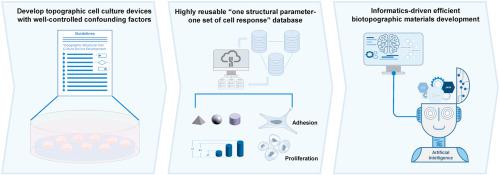Bioactive Materials ( IF 18.0 ) Pub Date : 2021-07-01 , DOI: 10.1016/j.bioactmat.2021.06.013 Yuanlong Guo 1 , Jiaomei Mi 1 , Chen Ye 1 , Yong Ao 1 , Mengru Shi 1 , Zhengjie Shan 1 , Bingzhi Li 1 , Zetao Chen 1 , Zhuofan Chen 1 , Krasimir Vasilev 2 , Yin Xiao 3

|
Micro/nano topographic structures have shown great utility in many biomedical areas including cell therapies, tissue engineering, and implantable devices. Computer-assisted informatics methods hold great promise for the design of topographic structures with targeted properties for a specific medical application. To benefit from these methods, researchers and engineers require a highly reusable “one structural parameter – one set of cell responses” database. However, existing confounding factors in topographic cell culture devices seriously impede the acquisition of this kind of data. Through carefully dissecting the confounding factors and their possible reasons for emergence, we developed corresponding guideline requirements for topographic cell culture device development to remove or control the influence of such factors. Based on these requirements, we then suggested potential strategies to meet them. In this work, we also experimentally demonstrated a topographic cell culture device with controlled confounding factors based on these guideline requirements and corresponding strategies. A “guideline for the development of topographic cell culture devices” was summarized to instruct researchers to develop topographic cell culture devices with the confounding factors removed or well controlled. This guideline aims to promote the establishment of a highly reusable “one structural parameter – one set of cell responses” database that could facilitate the application of informatics methods, such as artificial intelligence, in the rational design of future biotopographic structures with high efficacy.
中文翻译:

促进信息学驱动的高效生物地形材料开发的实用指南
微/纳米拓扑结构在许多生物医学领域(包括细胞疗法、组织工程和可植入设备)显示出巨大的实用性。计算机辅助信息学方法对于设计具有特定医疗应用目标特性的地形结构具有巨大的前景。为了从这些方法中受益,研究人员和工程师需要一个高度可重用的“一个结构参数 - 一组细胞反应”数据库。然而,地形细胞培养装置中现有的混杂因素严重阻碍了此类数据的获取。通过仔细剖析混杂因素及其可能出现的原因,我们制定了相应的地形细胞培养装置开发指南要求,以消除或控制这些因素的影响。根据这些要求,我们提出了满足这些要求的潜在策略。在这项工作中,我们还根据这些指南要求和相应的策略,实验演示了一种具有受控混杂因素的地形细胞培养装置。总结了《拓扑细胞培养装置开发指南》,指导研究人员开发消除混杂因素或良好控制的拓扑细胞培养装置。该指南旨在推动建立高度可重用的“一个结构参数—一组细胞反应”数据库,促进人工智能等信息学方法在未来高效生物地形结构合理设计中的应用。











































 京公网安备 11010802027423号
京公网安备 11010802027423号